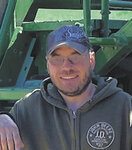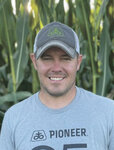




Editor’s note: Dairy Star aims to provide our readers with a closer look into relevant topics to today’s dairy industry. Through this series, we intend to examine and educate on a variety of topics. If you have an idea for a topic to explore in a future issue, send Stacey an email.
MISHICOT, Wis. — When Steven Rahmlow received too many complaints for using an airplane to spray fungicide on his corn, he decided to use a drone instead.
“I absolutely loved it,” Rahmlow said. “The drone gets a lot closer and provides a lot better coverage than a plane.”
Rahmlow and his family milk 1,150 cows and farm 4,000 acres, growing soybeans, winter wheat, alfalfa and corn, at Cedar Springs Dairy Farm near Mishicot.
“We always used an airplane to spray our corn,” Rahmlow said. “When people see planes flying around, it throws up a huge red flag, and you get complaints.”
Rahmlow is going on his third year of hiring a drone operator to spray the fungicide. After spraying fields by drone the first year, Rahmlow needed 1,674 acres sprayed the following year, and he had the drone applicator do it all.
“The drone is a lot smaller, and no one sees it,” Rahmlow said. “People don’t know there is someone out there spraying. We had zero complaints.”
When the need to spray a crop or plant cover crop seed arises, dairy farmers can turn to drones to get the job done. They use drones to control insects, weeds and fungus, and to deliver nutrients to crops and seed for cover crops. Farmers might also use smaller camera drones to inspect fields and check crop health.
From cover crop aerial seeding and herbicide and fungicide application to doing test plots and crop scouting, drones have many uses in agriculture.
“A drone is such an awesome tool for someone with a growing operation,” said Jeramy Williams, owner of American Drone. “Drones offer the benefit of traditional aerial applicators but put the control in your hands. If you own the aircraft, you can do this yourself whenever you want. You don’t have to wait on a fixed wing or have a lot of acres to justify one coming into your area.”
A drone can get onto a field even when it is wet, ensuring timely application without leaving any evidence that it was there. When the ground is soft in spring, a ground applicator can make ruts in the field or get stuck, Williams said.
“You’re going to run over 3 bushels per acre just by driving the machine out there,” he said. “You are losing yield by pounding corn or soybean into the ground.”
American Drone provides liquid and dry aerial applications. It also runs a full-service dealership near Marshfield.
“We help them through the whole process, including all the legalities and regulations,” Williams said. “We train people and make sure they are safe, legal and confident in using drones. We are the only dealer of agricultural drones in Wisconsin that is also a custom applicator. We work with and service the two largest and most advanced drone brands: DJI and XAG.”
A drone can enter a field at any stage in the plant’s life. Drones can also access hard-to-reach places like waterways, terraces, fence rows and tree lines. They can be used with success on rough, rocky or steep terrain and do applications near congested areas. When using a drone, the application stays on-site without drifting. In addition, drones target only those areas of a field that require spraying.
“With a drone, you can be very specific about where you spray,” Williams said. “If you have a 100-acre field with only 10 acres of weeds, you don’t need to put 100 acres’ worth of product out there. The precision inside of these drones allows them to be very accurate.”
Brooke Stewart, owner of AgriDrone LLC, is a custom applicator, certified crop adviser and agronomist. Operating out of Luxemburg, Stewart specializes in chemical and cover crop applications using a drone. She performs liquid and dry aerial applications, applying fungicide on corn, soybeans, winter wheat and alfalfa as well as planting cover crop seed.
“Pretty much anything you spray in agriculture can be done with a drone,” Stewart said. “From field and vegetable crops to orchards, vineyards and forestry — all these industries can utilize drones.”
The drone flies 10 feet above the crop canopy with a swath of 30 feet at a rate of 25 acres per hour. Stewart said the cost for an application is about $20 per acre for an average-size field.
“For a farm with a lot of small fields or higher rates of application, I would charge an hourly rate,” Stewart said.
Stewart sprays at a rate of 2 gallons per acre.
“That’s a typical rate we use to be efficient with the drone,” she said. “You can cover 25-40 acres per hour, depending on the type of drone you have.”
Stewart flies a DJI Agras T30, which has a 30-liter tank or about 8-gallon payload capacity, which is equivalent to 50 pounds of seed or granular.
When planting cover crops, Stewart plants a winter rye mixture, clovers, brassicas and turnips at a rate of anywhere from 5-30 pounds per acre.
Last year, American Drone spread over 26,000 pounds of cover crop seed.
“Spreading cover crop seeds into standing corn that’s 8 feet tall can be done easily with a drone,” Williams said. “By the time you cut the corn, the cover crop is germinating already.”
Williams also applies foliar feed to crops via drone.
“Instead of dumping hundreds of pounds of nitrogen on the crop at once, the drone spoon feeds foliar feed to the crop 3-4 times throughout the plant’s life cycle,” he said. “It lands on the leaves, and the plant takes it in. People are seeing a big bump in yield from that.”
Williams also recommends using drones to spray pastures.
“If you have a pasture that’s hilly, rocky and full of thistles, and you want to take out the thistles, drones are awesome for that,” he said.
Shawn Verhulst, a crop consultant near Marshfield, helps his customers get set up with a drone applicator if they wish to go that route.
“Most of the dairy farmers I work with are using drones to apply fungicide on corn silage,” Verhulst said.
Verhulst said it is mainly bigger farms using a drone on their brown mid-rib corn silage, about 5%-10% of his clientele. As a service to his customers who buy fungicide from him, Verhulst lines up the drone application and ensures the farmer has the maps, water and other supplies needed for the operator.
“There are still quite a few farms with their own sprayer or they have the co-op do it,” Verhulst said. “If they don’t have their own sprayer, I recommend using a drone on the corn silage. I can help get the drone set up so the timing is correct. Timing is really critical for fungicide, and we can get the timing at the right stage with the drone.”
Rahmlow applies fungicide to prevent tar spots.
“We didn’t put it on one field, and it was almost 30 bushels of a difference,” he said. “The plant died a lot sooner that year, and we lost tonnage.”
Rahmlow is considering trying the drone with soybeans this year.
“We’re also thinking about getting our own drone in the future,” he said. “If I had a drone, I would maybe spread more cover crops instead of running equipment over the field.”
Rahmlow said the only drawback of a drone is that it takes longer than an airplane.
“Airplanes are a little faster, but I’m getting better coverage with the drone, and the cost is about the same,” he said.
If a farmer is interested in purchasing a drone, Williams recommends working with a supplier that is also an applicator.
“Talk to a supplier who can work with you as a partner, train you and walk you through the process,” he said. “Make sure you’re not just buying a drone because they’re new and cool. … You need to be making that capital equipment purchase for a reason.”
Williams said the investment for a drone, including training and all associated equipment, is about $60,000.
“The average return on investment is only 17 spray days or application days,” Williams said. “I’ve had many customers prove that.”
Many licenses are required to fly a drone. These include Federal Aviation Administration Part 107 to fly a basic drone, FAA Part 137 to operate a drone more than 55 pounds, a state aerial applicator license, a state chemical applicator license and a third class medical certificate.
Stewart said the operator must maintain a visual line of sight of the drone and avoid power lines, wood lines and other obstacles. A short battery life can be a drawback as batteries typically last 6-8 minutes or 4-5 acres.
Drones are proving beneficial in helping farmers manage their crops, and Stewart said the demand for drone work is high.
“There are new crews and people getting into it this year,” she said. “It’s really taking off.”
Williams said American Drone is adding more capacity to the industry by setting up dealerships.
“A drone is an amazing tool, but you have to be able to use it legally, safely and effectively,” Williams said. “There are a lot of federal and state regulations to follow, and civil aviation safety is our top priority. We want to make sure that when people fly these in the national airspace system, they’re doing it safely.”
Comments
No comments on this item Please log in to comment by clicking here